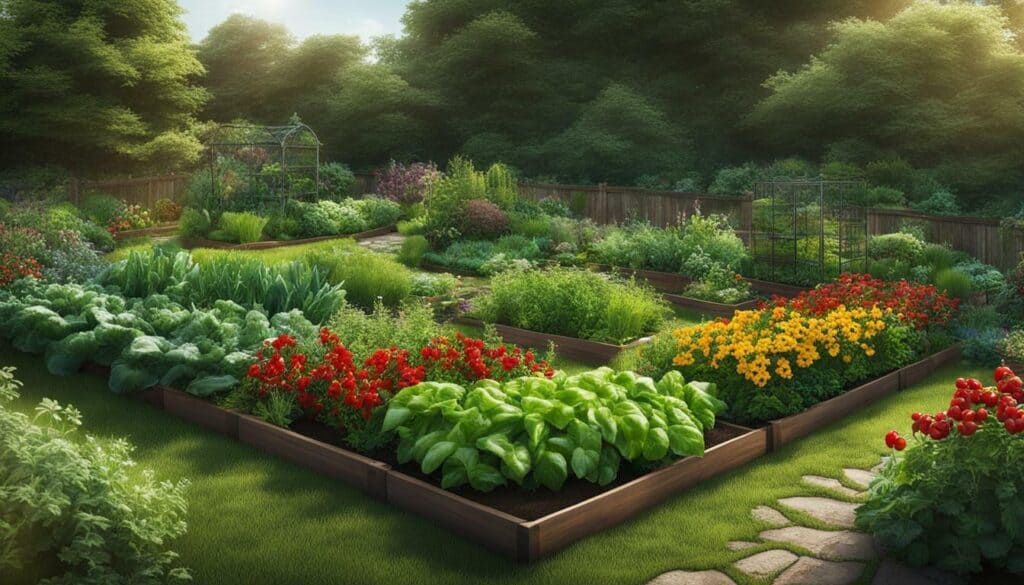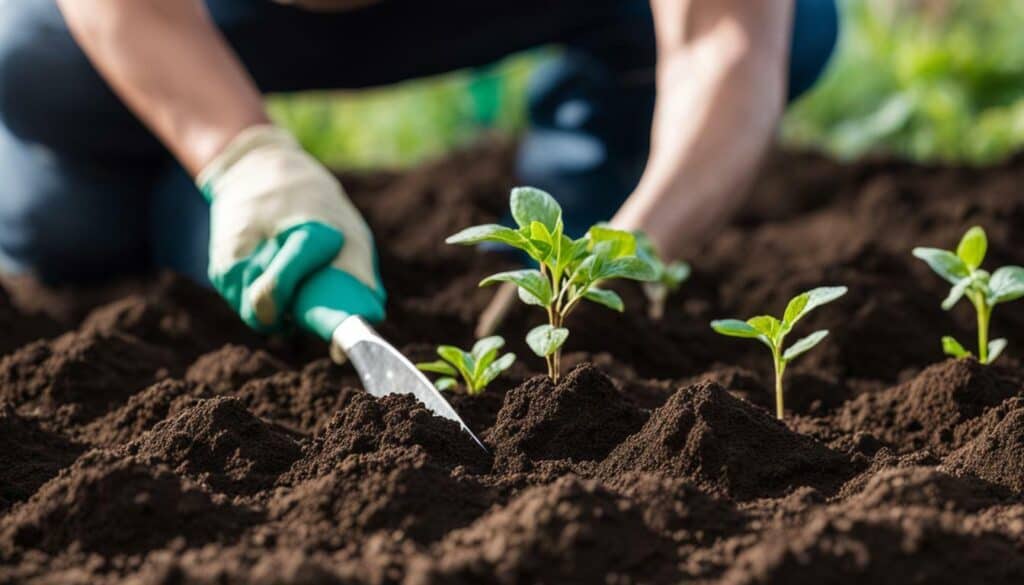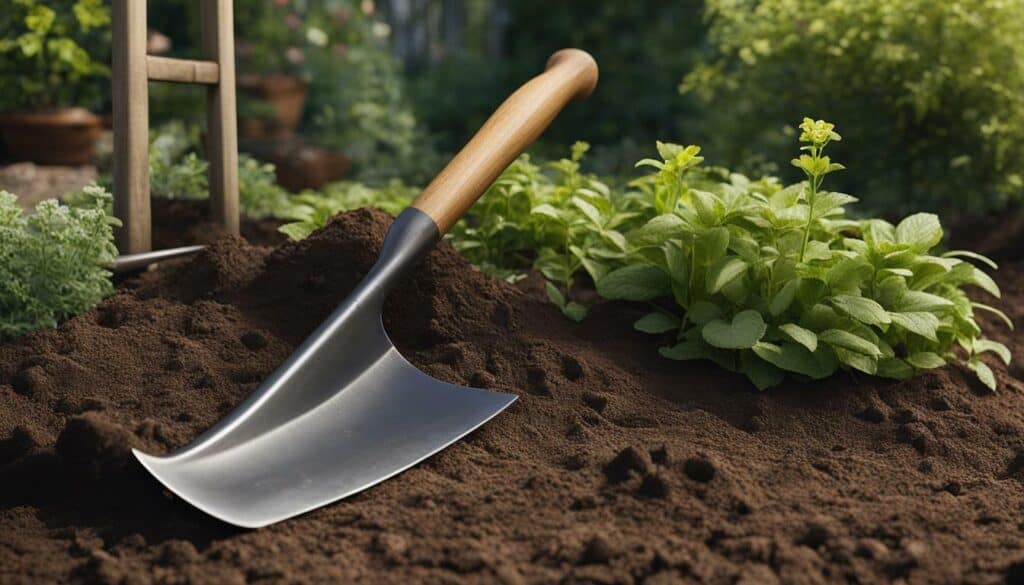Starting a vegetable garden can be a cost-effective way to enjoy fresh produce while connecting with nature. As a beginner gardener, it’s important to start small and learn the basics before investing too much time and money. Here are some easy tips for beginners to get started with their first time garden:
Key Takeaways:
- Start with a small space and plant what you love to eat.
- Choose a spot with at least 6 to 8 hours of direct sunlight and convenient water access.
- Decide on a garden layout and start with nutrient-rich soil.
- Choose the right plants for your climate and growing season.
- Invest in essential gardening tools for success.
Starting Small and Choosing the Right Size
Beginners should start small and choose a 6×6 feet garden or containers to learn the basics. It’s essential to start with a small space and be thrilled with the results rather than being overwhelmed by a larger garden. A good size for a beginner’s vegetable garden, for example, is 6×6 feet.
By selecting up to five types of vegetables to grow, you’ll have plenty of fresh produce for your summer meals while easily keeping up with the chores. When deciding what to grow, it’s important to choose plants that you love to eat. Pay attention to the descriptions on seed packets, tags, or labels to ensure you select varieties that suit your preferences and care needs. Consider how much you and your family will eat and be realistic about how many seeds or plants you need. It’s crucial to plant successive crops to have a continuous harvest throughout the seasons.
In terms of the garden layout, you can either choose row cropping or intensive cropping depending on the space and equipment you have available. Row cropping is suitable for larger gardens and makes it easier to use mechanical equipment, but it limits the number of vegetables you can plant due to the space set aside for footpaths. Intensive cropping, on the other hand, maximizes the use of prepared soil by spacing plants closely together, but it requires weeding by hand. Additionally, you can try the square-foot method, which subdivides a raised garden bed into 1-foot squares, allowing you to mix and match different plants.
If you don’t have a yard, growing vegetables in containers on a sunny deck or balcony is also a great option. When selecting a space for your garden, make sure it receives plenty of sunlight. Most vegetables require at least 6 to 8 hours of direct sunlight a day. If your yard has partial shade, choose vegetables and herbs that tolerate those conditions. Also, consider convenient water access and the availability of a water source nearby for frequent watering, especially during the first few weeks after seeds germinate or seedlings are transplanted.

Growing Vegetables You Enjoy
It is important to grow vegetables that you enjoy eating and consider factors like productivity and successive crops. Starting with a small space, such as a 6×6 feet garden or containers on a sunny deck or balcony, is recommended for beginners.
| Vegetable | Sunlight requirements | Productivity | Successive crops |
|---|---|---|---|
| Tomatoes | 6-8 hours | High | Plant every 2-3 weeks for continuous harvest |
| Peppers | 6-8 hours | High | Harvest regularly to encourage new growth |
| Lettuce | Partial shade | Medium | Plant in 2-week intervals for continuous harvest |
| Zucchini | 6-8 hours | High | Pinch off old blooms to encourage new ones |
Providing your vegetable garden with lots of sunlight is crucial, as most vegetables need at least 6 to 8 hours of direct sunlight a day. Accessible water sources nearby are also important for frequent watering during the early stages of growth. When planning your vegetable garden layout, you can choose between row cropping or intensive cropping, depending on your gardening goals and available space.
Starting plants in rich soil and selecting the right plants for your growing conditions, considering your hardiness zone and frost dates, are essential for a successful garden. Having the necessary garden tools, such as a shovel or trowel, hoe, rake, pruners, and gloves, is important for efficient gardening. Choosing a suitable space for your garden, preferably flat with good sun exposure and accessibility, is key. Testing and preparing the soil, including pH testing and adding organic matter, will help create a suitable environment for your plants. Depending on the size and design of your garden bed, you can remove sod, loosen the soil, and incorporate compost.
Choosing seeds of easy-to-grow varieties, like zinnias and lettuce, will increase your chances of success. With these tips, you can start growing vegetables you enjoy and have a bountiful harvest.

Finding the Perfect Spot for Your Garden
The garden should be located in a spot that receives at least 6 to 8 hours of direct sunlight a day. This is crucial for the growth and productivity of your plants. If your garden spot has partial shade, choose vegetables and herbs that can tolerate those conditions.
A good approach for beginner gardeners is to start small. If you have limited space or are new to gardening, consider starting with a small garden or containers. An ideal size for a beginner’s vegetable garden is 6×6 feet. Growing vegetables in containers is also a great way to start if you don’t have a yard.
When choosing what to plant in your garden, it’s important to consider what you love to eat. This will ensure that you are more motivated to take care of your plants. Pay attention to the characteristics of each vegetable variety and think about how much you and your family will eat. Planting both cool- and warm-weather vegetables will ensure a continuous harvest throughout the spring, summer, and fall.
In addition to sunlight, water access is also an essential factor in choosing the perfect spot for your garden. Consider the proximity of your garden to a water source and how easy it is to access the water.
When planning your garden layout, you can choose between row cropping or intensive cropping. Row cropping is suitable for larger gardens and makes it easier to use mechanical equipment for weed control. Intensive cropping, on the other hand, maximizes space and productivity by planting plants close together. You can also use the square-foot method for a specialized version of intensive cropping.
Before starting your garden, it’s important to choose plants that match your growing conditions. Consider your hardiness zone to determine what plants are likely to grow well in your area. Knowing your frost dates will also help you avoid planting too early or late in the season.
Once you have chosen what you want to plant, bought the necessary tools, chosen a suitable space, tested and prepared the soil, and started a garden bed, you are ready to begin your garden. If you have limited space or a lack of sunlight, you can also consider growing plants in containers.
In conclusion, finding the perfect spot for your garden involves starting small, considering what you love to eat, ensuring sufficient sunlight and water access, and planning your garden layout wisely. Taking these factors into account will help you create a thriving and productive garden.

Choosing the Right Garden Layout
The garden layout can be either row cropping or intensive cropping, depending on the space available. Starting with a small space is recommended for beginner gardeners. A 6×6 feet plot is perfect for growing up to five types of vegetables. Growing vegetables that are enjoyed and considering factors such as variety, productivity, and successive crops is vital.
The location of your garden is crucial, with direct sunlight being necessary for most vegetables. Select a spot with easy access to water as well. The intensive cropping method utilizes every square inch of soil, while row cropping is best suited for larger plots of land.

It is essential to start plants in rich soil for the best harvest and know your hardiness zone and frost dates to determine what plants will thrive. Testing and preparing the soil, and starting a garden bed are crucial aspects to consider. Having essential garden tools and choosing a suitable space for your garden are also important steps in starting a garden.
Lastly, choosing the right seeds, especially those that are easy to grow, is key to a successful garden.
Starting with Rich Soil
It is important to start plants in rich soil to ensure a bountiful harvest. A nutrient-rich soil provides plants with the necessary nutrients for healthy growth and development.
Before planting, it is recommended to test and prepare the soil. Knowing the pH level of your soil can help you determine which plants will thrive in your garden. Most vegetables prefer a pH level between 6.0 and 7.0. You can test your soil with an inexpensive kit available at most garden centers or by sending a sample to a soil testing laboratory.
Adding organic matter like compost to your soil can improve its quality. Compost is a natural fertilizer containing nutrients essential for plant growth. It also helps improve soil texture and structure, allowing for better water retention and drainage.
When preparing your garden bed, remove any sod and loosen the soil to a depth of at least six inches. Consider the size and design of your garden bed, making sure to give your plants enough space to grow. Be sure to choose seeds that are easy to grow for beginners.

Starting with rich soil sets a solid foundation for a successful and rewarding gardening experience. By taking the time to prepare your soil, you are investing in the future of your garden and ensuring that your plants have the best chance at producing healthy and delicious vegetables.
Choosing the Right Plants and Timing
When choosing plants, consider your growing conditions and hardiness zone. Starting with easy plants for beginners, such as tomatoes, lettuce, and herbs, is recommended. It is important to grow what you love to eat and consider the size and care needs of each vegetable variety.
Planting both cool- and warm-weather vegetables allows for a continuous harvest throughout the seasons. For example, broccoli, cabbage, and carrots prefer cooler temperatures, while tomatoes, peppers, and cucumbers thrive in warm weather. Understanding your hardiness zone and frost dates will help you pick suitable plants and determine the right time to plant them.
Additionally, preparing the soil is crucial for optimal growth. Testing its pH level and adding organic matter if necessary will create a nutrient-rich environment for your plants. Whether gardening in a raised bed or a traditional garden, spacing plants properly and considering their mature size and spread is also important.
Lastly, selecting seeds that align with your gardening goals is advised. If you want fast results, consider growing plants that mature quickly, such as radishes, beans, and peas. If you want to save money, choose plants that produce high yields, such as zucchini, squash, and tomatoes.
By following these beginner gardening tips, you can choose the right plants and time your gardening activities effectively to ensure a successful harvest.

Essential Tools for Gardening Success
Starting a garden requires selecting the right tools, such as a shovel, hoe, rake, gardening knife, pruners, and gloves. It is essential to choose high-quality metal tools that are properly maintained to ensure their longevity and effective use. Here are some additional tips to help you choose the right tools for your first time garden:
| Tools | Function |
|---|---|
| Shovel or Trowel | Used for digging holes, planting, and transplanting seedlings. |
| Garden or Scuffle Hoe | Used for weeding and loosening soil. |
| Rake | Used for leveling soil and removing debris. |
| Gardening Knife | Used for multiple tasks, such as cutting twine and opening bags of soil. |
| Pruners | Used for cutting stems, branches, and deadheading flowers. |
| Gardening Gloves | Used for protection from thorns, cuts, and scratches. |
While having these tools is important, do not forget to keep them in good condition by cleaning and sharpening them regularly. This will make your gardening tasks easier and more enjoyable.
Remember, starting a first time garden can be a fun and rewarding experience. With the right tools and steps, you can grow your own fresh produce and elevate your cooking skills. Now that you have learned the essential tools for gardening success, get started on your first garden today!

Conclusion
In conclusion, starting a first time garden can be a rewarding experience for beginners, and with these easy tips, you’ll be on your way to gardening success. Growing your own vegetables is not only a cost-effective way to have fresh produce but also a way to connect with nature and enjoy the outdoors. Remember to start small and choose vegetables that you love to eat. Factors such as the amount of produce you can consume and the different seasons for growing cool-weather and warm-weather vegetables should also be considered.
When selecting a spot for your garden, ensure that it receives at least 6 to 8 hours of direct sunlight and has easy access to water. Row cropping and intensive cropping are the two common garden layouts to choose from based on available space. Ensure that your plants are getting the proper nutrients by starting with rich soil and considering its pH level. Choose plants based on growing conditions, hardiness zone, and frost dates to avoid planting too early or late. It is also important to have the necessary tools, such as a shovel, hoe, rake, and gloves, to ensure success in your first time garden.
Test and prepare the soil by removing sod and loosening the soil to provide enough space for each plant. Consider vertical gardening to maximize space. Lastly, choose seeds that align with your gardening goals and are easy to grow. With the necessary effort and attention to detail, you can successfully start and maintain a garden that brings freshness, flavor, and joy to your life.
What Are Some Simple Tips for Beginner Gardeners to Grow Their Own Garden Successfully?
Are you a beginner gardener? Check out this simple homegrown garden guide to help you succeed in growing your own garden. Start by selecting the right plants for your climate and soil. Ensure they receive adequate sunlight and water them regularly. Apply organic fertilizers and remove weeds to promote healthy growth. Remember, patience and consistency are key in gardening.
FAQ
Q: What size garden should I start with as a beginner?
A: It is recommended to start with a 6×6 feet garden or containers to learn the basics.
Q: What factors should I consider when choosing which vegetables to grow?
A: You should grow vegetables that you enjoy eating and consider factors like productivity and successive crops.
Q: Where should I locate my vegetable garden?
A: Your garden should be located in a spot that receives at least 6 to 8 hours of direct sunlight a day and has convenient water access.
Q: What are the two common garden layouts?
A: The two common garden layouts are row cropping and intensive cropping.
Q: How do I start plants in rich soil?
A: It is important to start plants in soil that is rich in nutrients. Adding compost or organic matter can improve the soil’s quality.
Q: How do I choose the right plants and timing?
A: Consider your growing conditions, hardiness zone, and frost dates to choose plants and avoid planting too early or late.
Q: What are the essential tools for gardening success?
A: Essential gardening tools include a shovel, hoe, rake, gardening knife, pruners, and gloves.
Source Links
- https://www.bhg.com/gardening/vegetable/vegetables/planning-your-first-vegetable-garden/
- https://miraclegro.com/en-us/gardening-101/10-top-gardening-tips-for-beginners.html
- https://www.gardensalive.com/product/first-time-veggie-gardenwhere-to-start
- https://www.almanac.com/vegetable-gardening-for-beginners
- https://byf.unl.edu/veggie-gardeneing-101-site-selection
- https://www.creativevegetablegardener.com/how-to-start-a-small-vegetable-garden/
- https://shiftingroots.com/10-easy-vegetables/
- https://www.almanac.com/where-put-vegetable-garden
- https://www.gardensthatmatter.com/choose-garden-location/
- https://www.bhg.com/gardening/yard/garden-care/ten-steps-to-beginning-a-garden/
- https://gardenerspath.com/how-to/beginners/first-vegetable-garden/
- https://www.almanac.com/soil-preparation-how-do-you-prepare-garden-soil-planting
- https://www.purdue.edu/hla/sites/yardandgarden/advice-for-first-time-gardeners-start-small/
- https://simplelivingcountrygal.com/best-gardening-tools/
- https://www.today.com/shop/best-gardening-tools-products-t114311
- https://www.gardenary.com/blog/my-favorite-kitchen-gardening-tools
- http://lizfabry.blogspot.com/2012/11/garden-update.html?m=1
- https://www.preciouscore.com/7-life-lessons-i-have-learned-from-my-first-garden/





Leave a Reply